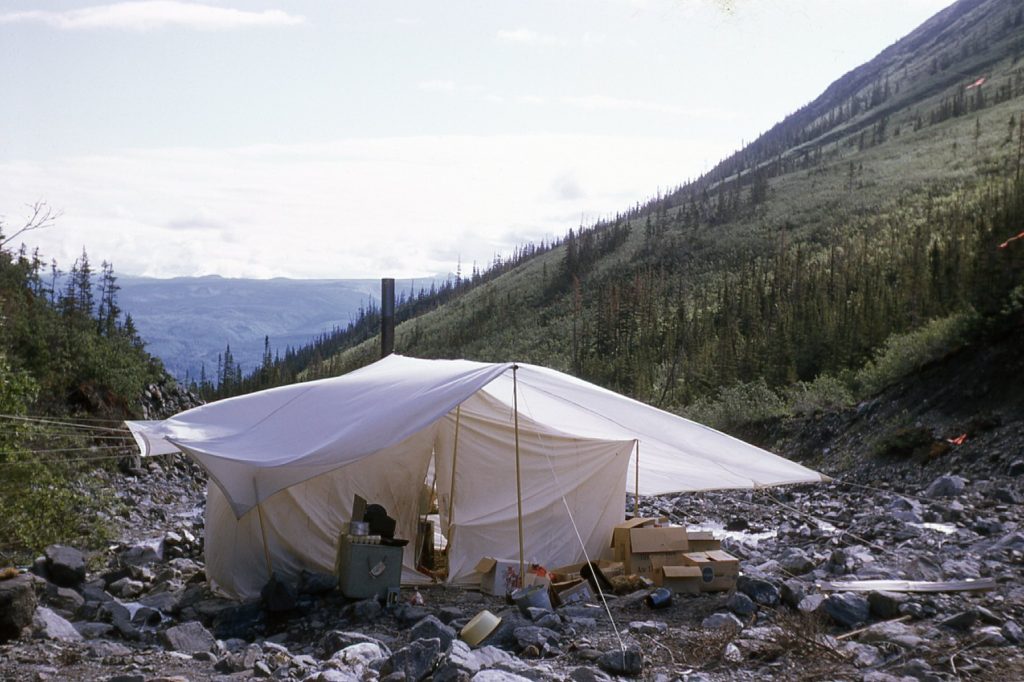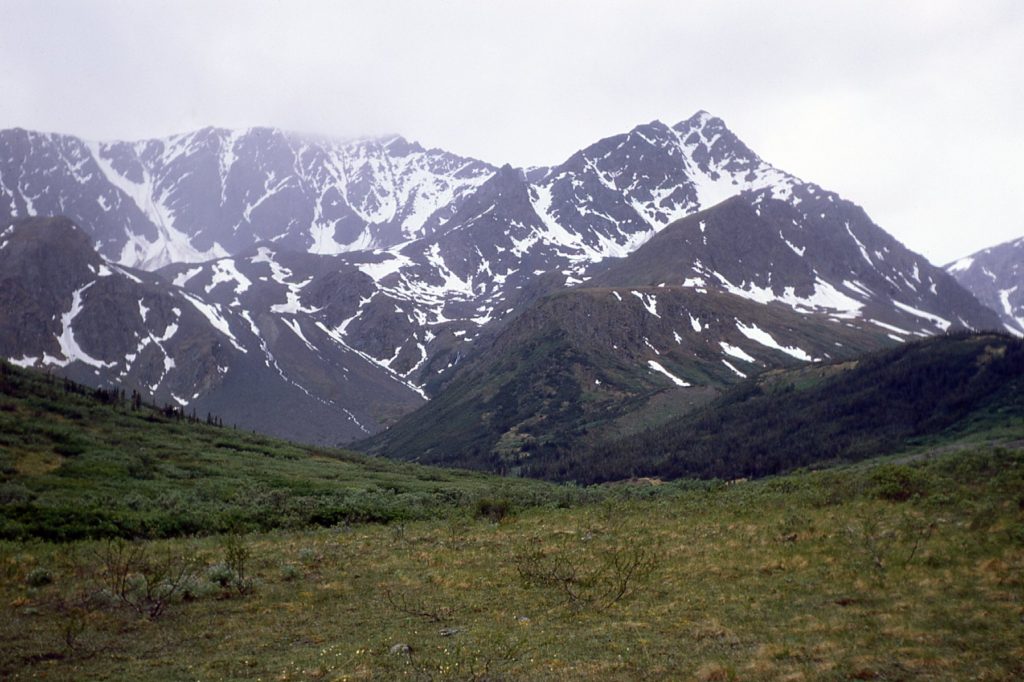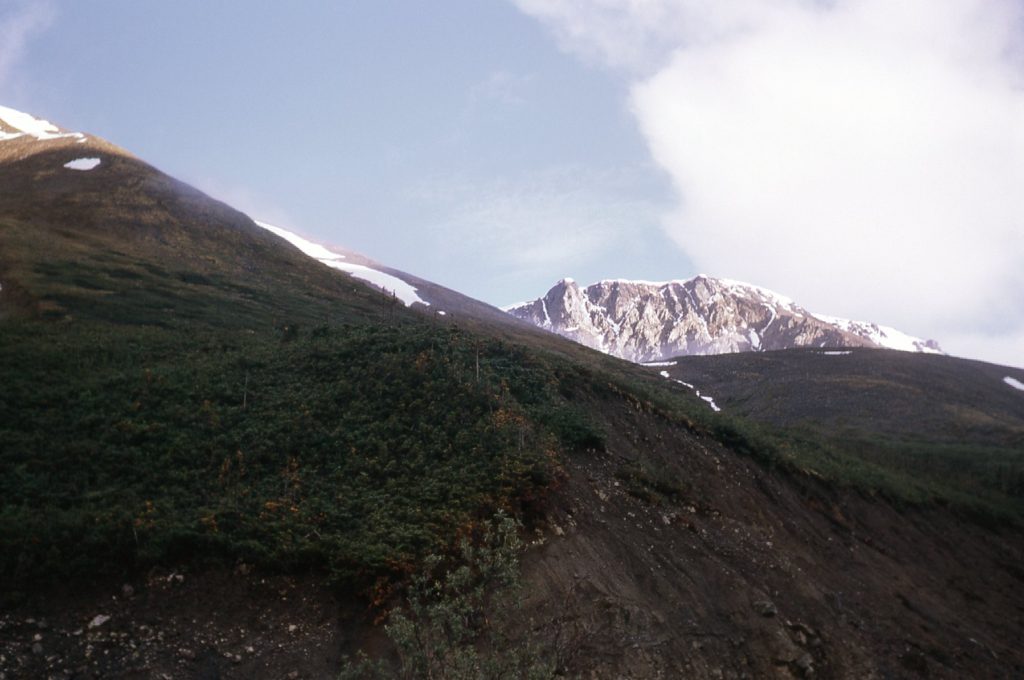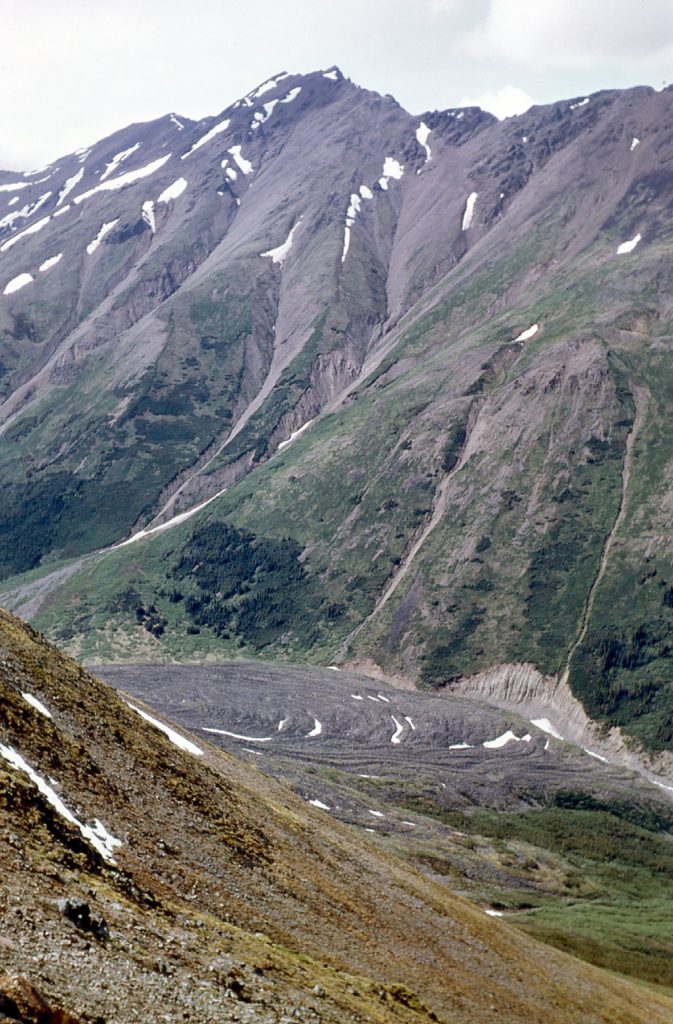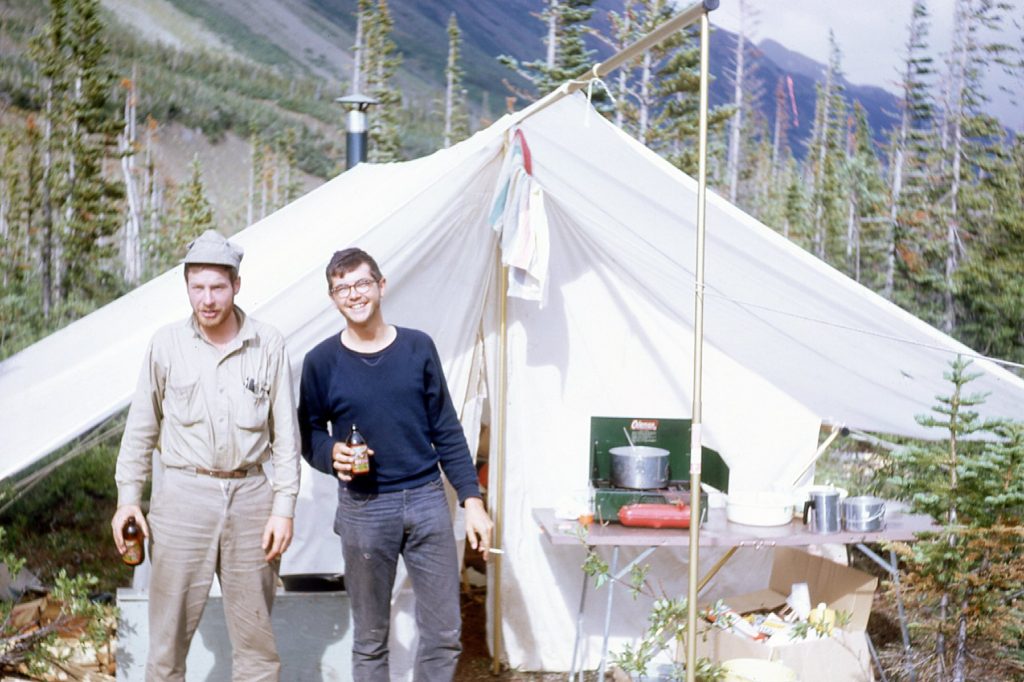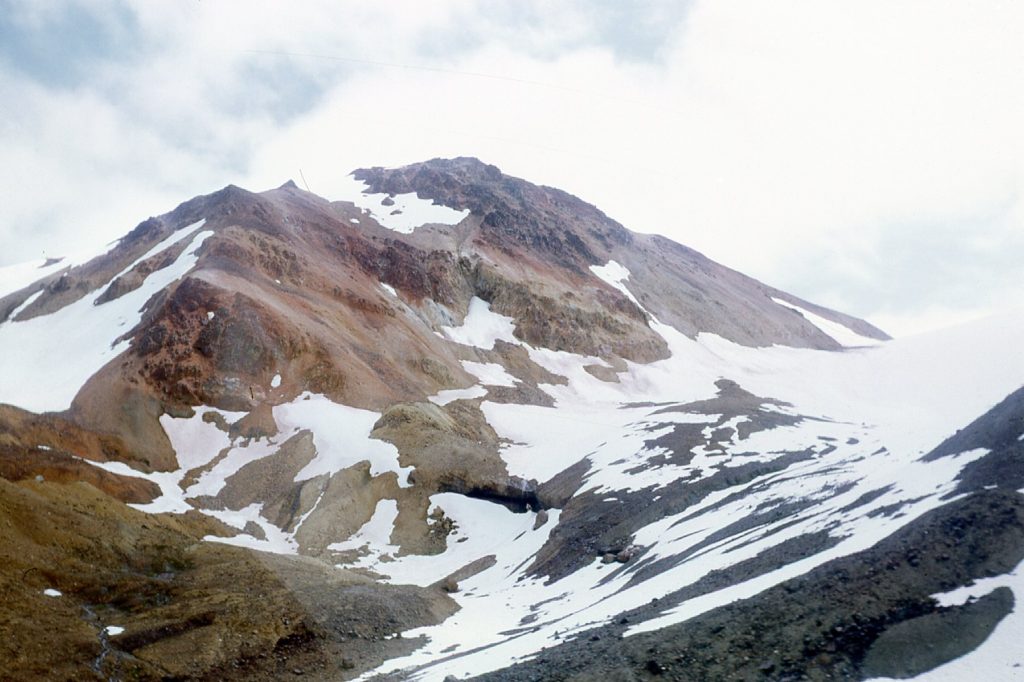Please be sure to read Parts 1 and 2 of this story before continuing with this one.
So now we were about to start sending men out on fly camps – I wasn’t too sure what to expect, but it sounded like an adventure. On June 26th, Al and I were transported by helicopter to a remote spot a couple of thousand feet up a valley, near tree-line. What a place! As you can plainly see, it was a rock-strewn creek bed – we had to work hard to move enough rocks around to even be able to get the cots level enough to sleep on.
You can see the pipe from our airtight wood-burning stove sticking up behind the tent – there was wood a-plenty, all we had to do was find it, chop it and keep the stove going to stay warm when we were at camp. We cooked our food on a 2-burner Coleman stove, and had plenty of it. It was a windy spot, and often froze at night. We’d head out together each day and prospect, going to different places each time. We had a 2-way radio powered by a car battery to keep in touch with base camp, and had a scheduled time to call them every evening. We also would try to contact our friends in the other fly camps to see how they were doing.
We’d cover a lot of ground each day. The nearby mountains rose thousands of feet above us, affording us all the exercise we’d ever want..
The scenery was great, and that made things nicer. We did have a lot of rainy weather, though, which would sometimes keep us tentbound all day.
From high on a ridge, we looked down into a neighboring valley and spotted something unusual – a rock glacier – you won’t see one of those every day. Google it.
Al and I spent a full 10 days in that camp, and it felt great to finally get back to base camp for better food and a shower (yes, we had built a shower, complete with hot water heated by wood).
Even though I got along really well with Al, the ten days spent out there gave me a better appreciation of all of the comforts of base camp. The daily routine at base felt really good for the next 6 days, but I knew the time would come to ship out again. On July 11th, Bob and I were flown out to our second fly camp of the summer, to a place called Ball Creek. En route, we stopped at one of the other fly camps where Norm and Bill were staying. We caught them at happy hour. Norm is the one on the left, and he was one crazy character – we nicknamed him AbNorm.
As we all stood around talking, the pilot had left the chopper running. It was sitting up on some uneven ground nearby, and one of the guys let out a shout. Much to our collective horror, the tail of the chopper was slowly settling down and soon the tail rotor would have hit some rocks. The pilot raced back to the chopper and got back in, making it more level and out of danger. If that tail rotor had hit those rocks, it would have been all over. With no tail rotor to stabilize the machine, it would have gone violently out of control and could have killed us or exploded or who knows what. Bob and I got back in and we took off, soon arriving at the site of our own fly camp.
This camp turned out to not be a happy place. Bob was an engineering student and I was a geology student. At our university, there was much rivalry between engineering and science, so putting the two of us together was like trying to mix oil and water. Also, he was several years older than I and we had nothing in common. The days passed slowly and we spoke very little. If it hadn’t’ve been for the fact that we had plenty to read, we probably would have gone crazy. I had a copy of “Atlas Shrugged”, which occupied all the time I needed it to. As with anyplace we went, the scenery was pretty good, like this spot within easy walking distance from camp.
The only event I really remember from the 12 days we spent there was the moose. One evening, around 6 or 7 PM, we were both laying on our cots reading – all was quiet. Dinner had been eaten and cleared away. We heard a strange noise, something we couldn’t put our finger on, but it was quickly getting louder. The tent door was wide open, so we could see out front. All of a sudden, a full-grown bull moose came crashing out of the bush, running fast, right toward our tent. You’ve seen in previous pictures how these fly-camp tents were tied down to nearby trees and rocks with a lot of guy lines strung out in every direction; also, there was our radio aerial. As the moose emerged from the bush at a gallop, he spotted our tent at the last moment and swerved to avoid us, missing us by mere feet, then running off in a new direction. It was all over in a few heartbeats. We both sat there in stunned silence, realizing how we had dodged a bullet. If a half-ton moose had run right into our tent while we were in it, we could have been badly hurt or even killed. Not only that, if its huge antlers had become tangled in all those cords, God only knows how much damage it would have done trying to thrash its way out of that mess.
One thing I really want to do by writing about the Stikine is impress upon you how amazing a place it is, especially in a mountaineering sense. When the famous naturalist John Muir visited the area in 1879, he had this to say:
“Alps rise beyond alps as far as the eye can reach…..needles and pinnacles innumerable like trees in groves. I never before had seen so richly sculptured a range or so many awe-inspiring inaccessible mountains crowded together.”
Just under 25 miles from our base camp stood a spectacular peak known as Mount Hickman. That second fly camp I was in was near it, and although we didn’t venture close, it was interesting to learn more about it. Turns out that 5 years after I had been there, it was climbed for the first time. Fred Beckey, perhaps the preeminent North American mountaineer of all time, went in there with 2 friends. After days of climbing on rock and ice, much of it technical, they reached the summit on July 19, 1972 for the first ascent. Early surveyors felt that Mount Hickman stood 9,700 feet high and that’s the height that Beckey used, but all recent measurements peg it at 9,117 feet. Here is a link that has no photo but does show the topography around the peak, and it’s a sea of ice.
It was July 22nd by the time the chopper mercifully came to pick us up and return us to base camp, ending my up-close-and-personal ordeal with Bob. Base camp life was great – there was plenty to do, and the company of many more people to enjoy. It was so much better than being cooped up in a tent with one guy full-time, especially if you didn’t get along too well together. If we needed any personal items, Becky, one of the gals in the office back in Vancouver, would obtain them and send them on to us. Sometimes it would take weeks, but she took good care of us.
I mentioned before that our base camp was by Yeheniko Lake. It was drained by Yeheniko Creek which headed north for about 15 miles to empty into the Stikine River. We never did know the origin of that word, but recently I discovered that in the local native language it is Yelhéenak’u, which means “Raven’s Little Creek.” One day, the 3rd of August to be exact, the chopper had dropped us off to do some snooping around at the mouth of the creek. As we stood there, a motorboat came along – we waved to them and they came over to us. Doug and Pete were as surprised as we were, as we were the only humans they had seen in their 160-mile journey all the way up the river from Wrangell, Alaska. They would go the last few miles to Telegraph Creek but no farther. Beyond that lay the Grand Canyon of the Stikine, an impossible barrier to all river traffic. We wished them well and they motored on.
Base camp was the place all of us wished we could be all of the time, especially if you were one of the grunts like me who was sent out on fly camps. The food was endless, and you didn’t have to cook it yourself. You could take a hot shower. There were always several people with whom you could socialize – you could play cards or horseshoes, or just talk. Depending on how many clothes you owned, sooner or later you’d have to do laundry. It was pretty simple: heat some water on the wood stove, pour it into a galvanized tub with some ivory flakes detergent and get out a washboard (the ones we had were glass, not metal) and start scrubbing away; rinse well and hang it all up on a line, which were around the camp in abundance.
Our 2 bosses could not have been any more different from one another. The big boss was George Westner, an arrogant German fellow with a PhD; the other boss was an Indian man named Ram Singh. Ram was fun, easygoing and well-liked by all, while George was condescending to everyone, especially Ram. As the summer wore on, it was obvious that George would sooner have been anywhere else than at our camp. Ram basically made all of the geology decisions and ran the show; George socialized little with anyone, was often sequestered in his tent, and when he did venture out it was to wander in the bush with his custom-made German rifle to see what he could shoot.
By the time August 7th rolled around, it was time for me to head out on another fly camp. This one would be different, as you’re about to see.
Stay tuned for the next installment of the story, entitled “The Stikine – Part 4”.

